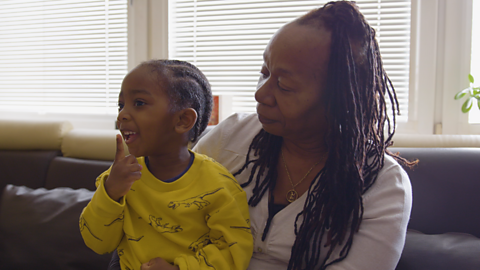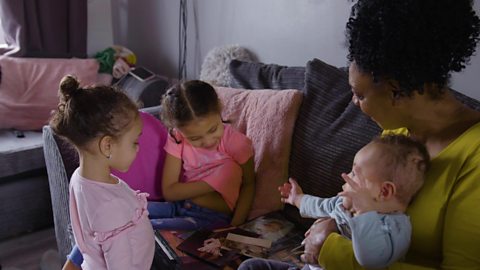Encourage your grandchild to explore your face - there's a lot for them to learn!
Take some time out to talk about your face and theirs and the differences between them. It's a great opportunity to learn lots of new naming words and descriptive words.
It's also a great chance to bond and learn more about each other.
Check out the video below to see how to make the most out of exploring faces together.
Where's my ear? There.
My ears. That's my ears. We'll I ain't got no hair have I?
No.
No!
Where's my nose.
There
There? Yeah.
You sure? Yeah.
And where is your mouth? There Is it a big mouth or a small mouth?
A big mouth!
Are you sure it a big mouth?
Yeah.
That means you're real big mouth boy.
What is this called Rafa'el?
That's my beard, isn't it.
Yeah.
Feel it and tell me what it feels like.
It's tickling me. It's tickling me!
What does it feel like.
Does it feel like hair?
No
No?
No?
No.
No?
Does it feel soft?
Yeah.
OK.
Why should you take time to explore faces with your grandchild?
- Repeating the parts of the face to your grandchild helps them learn new vocabulary.
- Giving your grandchild choices between two parts of the face allows them to develop an understanding of word meanings.
- Talking about faces is a great chance to teach new describing words like soft, big, small.
- Pulling faces allows you to introduce your grandchild to the concept of opposites - you mouth can be open or closed and happy or sad.
- Playing a guessing game with faces helps children pick up on body language and facial expressions linked to certain feelings.

Top tips for exploring faces together
Depending on your grandchild's age and stage, there are lots of different ways to teach them new words and have fun while playing with faces.
Encourage your grandchild to explore your face. You can point at parts of your face and say the word. See if your grandchild copies you.
If they can copy you, you can expand on their word by adding new descriptors such as, "granny's nose" or "green eyes". Repeat these phrases as you point and play to help your grandchild start to pick up new vocabulary.
Ask them to name a part of the face that you point to. If they donβt know the word, you can give them a choice - "Are these my eyes or my nose?"
Why not try making some funny faces and describing what you're doing? This helps introduce new words like "open eyes", "eyebrows up". It's also a great starting point for teaching opposites.
As your grandchild develops, they might be able to talk about the differences between faces. What colour hair do you have? Is that the same as them?
This is also a lovely time to talk about family features that you might share too.

More games to play with faces
There are loads of different types of games you can play just with your faces. All of them have different language benefits. We've listed some belowβ¦
- Looking in mirrors: Mirrors are great for exploring faces close up and developing self-awareness.
- Simon says: Test your grandchild's understanding of the face by asking them to point to certain features.
- Drawing faces: This is a great activity to help your little one talking about different emotions.






